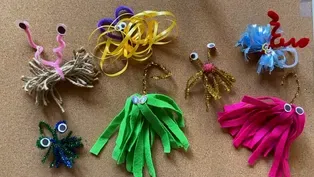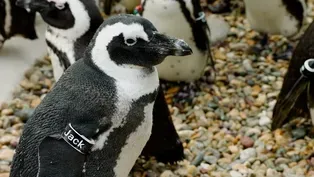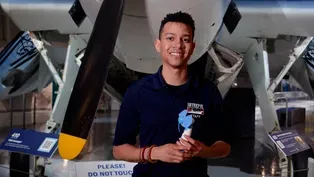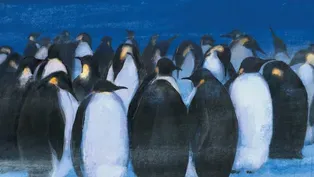
Waddling Challenge
Clip: 6/30/2023 | 14m 50sVideo has Closed Captions
Can Zing waddle as well as a penguin? Get moving with this penguin waddling challenge.
Can Zing waddle as well as a penguin? Get moving with this penguin-themed waddling challenge.
Problems with Closed Captions? Closed Captioning Feedback
Problems with Closed Captions? Closed Captioning Feedback
Camp TV is a local public television program presented by THIRTEEN PBS

Waddling Challenge
Clip: 6/30/2023 | 14m 50sVideo has Closed Captions
Can Zing waddle as well as a penguin? Get moving with this penguin-themed waddling challenge.
Problems with Closed Captions? Closed Captioning Feedback
How to Watch Camp TV
Camp TV is available to stream on pbs.org and the free PBS App, available on iPhone, Apple TV, Android TV, Android smartphones, Amazon Fire TV, Amazon Fire Tablet, Roku, Samsung Smart TV, and Vizio.
Providing Support for PBS.org
Learn Moreabout PBS online sponsorship[ Whimsical tune plays ] Happy day, Camp TVers.
And what a happy day it is, indeed.
Zing here, your head counselor, and today we are celebrating my all-time favorite animal, found on land, sea, and air.
Oh, wait, scratch the air part.
Even though they're technically a bird, they can't actually fly.
But that doesn't get in its way.
-[ Chattering ] -In fact, they make up for being grounded in more adorable ways than one.
Waddle, slide, and glide.
These masterful jumpers -- Whoops!
Mostly -- are always black-tie-ready and their coloring provides more than just good looks.
Their black and white feathers act as a form of camouflage, disguising them from potential predators.
From above, the black on their back helps them blend in with the darkness of the ocean and from below, the white on their belly helps them blend in to the bright surface of the water.
They're fast swimmers, too, able to reach speeds of up to 22 miles per hour.
-[ Squawking ] -I mean, what's not to love?
A beauty like this emperor penguin.
A wacky wonder like this macaroni penguin.
These guys are bound to put a smile on your face.
So, ready to dive in?
Excellent!
Because today is Penguin Day on "Camp TV."
No time to chill right now, though.
Your first activity awaits.
♪♪ ♪♪ -This is Dot and she is just about three months old.
-And this is Lucas and he's about a month older than Dot.
-These guys were hand raised from day one.
We actually acquired these eggs from Minnesota Zoo as part of a breeding loan.
Once they got big enough and lost most of their baby down, at about six weeks old, we introduced them to a pool back in holding, where it was a safe place to swim.
And once we were confident in their swimming abilities, we introduced them to whatever members of the colony wanted to come into a back area and meet them.
♪♪ ♪♪ -These penguins are definitely spunkier than any of the penguins we've worked with.
We like to call them spirited.
They're very curious.
They want to know all of the people business that's going on, just as much as we want to know all the penguin business that's happening in the exhibit.
-We have a 200,000-gallon pool here.
It's all manufactured saltwater.
Water temperature is a brisk...
The reason the temperature is that low is because the penguins, in their natural habitat, live at the southern tip of South Africa, where most of the water that these guys swim in is much, much colder than what we have in the pool here.
-These birds are designed for this marine lifestyle.
They've got a nice layer of fat, as well as very dense feathers.
They have the most dense feathers of any bird species in the world, about average 60 feathers per square inch.
The way those feathers line and interlock actually prevents the water from penetrating through to their skin, so, they may look wet when they come out onto land, but they're actually dry underneath, so, they have their own personal dry suit.
The sharks that are in the water with them are leopard sharks.
Now, this species can be found here on our Pacific Coast, but they're very similar to a species of shark that they would naturally live with in the wild in South Africa and the sharks in here do not eat penguins.
They actually are competitors -- they eat the same thing as the penguins.
So, they are a bottom-dwelling shark with a small mouth, little teeth, and they enjoy eating fish, squid, and occasionally, they'll eat a fish the penguin drops, or vice versa, the penguin will eat a fish that the shark drops.
-We work with them every day and we appreciate their personalities and we just love them as an animal.
But their numbers in the wild are very, very threatened.
They estimate that there's only about 18,000 breeding pairs left.
So, the more people we can get to meet these birds and fall in love with them, the more people will care about preserving the habitat and doing what they can to help their wild counterparts.
-Hello, everyone.
My name is Jonathan Millard and I'm a museum educator at the Intrepid Sea, Air & Space Museum.
Today, we're going to be learning all about propellers.
So, we're talking about propellers because, at the Intrepid Sea, Air & Space Museum, we have a lot of aircraft and we have a very large aircraft carrier and these things move using propellers.
A lot of people, when they think of propellers, think of something almost like this fan because propellers are a type of fan.
So, when I turn this fan on, we can have air move and that air I feel moving towards me right now.
So, we can use these fans to give ourselves a nice breeze, but we can actually use propellers to do something pretty interesting.
Because fans can move that air around towards something, but propellers, they use the air around them to actually move.
So, we already mentioned that fans can move air around, so, let's try moving air around ourselves.
So, if we take our hand and just move it around, you might feel a lot of wind around your hand.
So, let's imagine, if we want a little less air to move around, you can actually take one finger and try spinning that around... [ Laughs ] ...and you can try, now using your whole hand to move air around.
You might notice there's a lot more air being moved around.
So, if you have a very large propeller, you can make really, really large amounts of air or, in this case, water, move.
What we have right behind me is one of Intrepid's four propellers.
Each propeller weighs about 27,000 pounds and helps Intrepid move about 30 miles per hour, which doesn't sound too fast, but when you have a ship that is 42,000 tons and is three football fields long, that's pretty impressive.
So, we have this propeller here that's able to help move Intrepid forward.
You might be asking, "How is that possible?"
So, I want you to think, if you've ever gone swimming before or if you've seen someone swim before, they might do something a little bit like this.
This is how I swim.
I don't know if I'm the greatest swimmer, but this is what I do.
And when I swim, I'm pushing water behind me.
What direction do you think I'll go if I push that water behind me?
I'm going to go forwards.
That's how propellers work.
They're pushing something backwards, so they can move forwards.
So, what we see here is a propeller that's meant to push a lot of water backwards, to help a very large ship, like Intrepid, move forwards.
So, the way that propellers work is they're moving around a fluid and that can be water or that can be air.
So, air is also a fluid.
But the interesting thing about water, it's a lot more dense than air.
There's a lot more stuff.
If you try moving your hand in air, it's a little bit easier than moving your hand in water.
Because of that, propellers are shaped a little bit differently.
So, we just looked at a propeller that can move around in water.
Let's look at a propeller that can move around in air.
Because we want to be able to accelerate and move that aircraft forward, we're going to need those propellers to spin very, very fast.
So, that is why the shape of these propellers is a little bit different from those propellers meant to move around water.
So, these propellers are going to spin a lot faster than we're going to see the propellers spinning around in water.
And you might notice the amount of rotors, or different sections within this propeller, there's only three here, when there were four in that propeller we looked at moving around in the water.
So, depending on your propeller, depending on how large your aircraft or whatever vessel that you're moving around is, you're going to see different types of propellers and different shapes, too.
So, we learned a lot about propellers today.
We saw propellers of different sizes, propellers of different shapes, propellers that can move ships, and propellers that can even move airplanes.
I want you to look at propellers that you might find in your very own home.
Look at a fan.
Take a look and see how much air it can push around when you turn it on.
Look at the shape of the blades.
Think about what was designed to help it function and do its job of moving that air around.
So, thank you all for joining us today and I hope you enjoy exploring and learning more about the world around you.
♪♪ [ Whistling ] ♪♪ ♪ Hey!
♪♪ ♪♪ ♪♪ ♪ Hey!
♪♪ ♪♪ ♪♪ ♪♪ ♪♪ ♪♪ ♪♪ ♪♪ ♪♪ ♪♪ ♪ Hey!
♪♪ ♪♪ ♪♪ ♪♪ ♪♪ ♪♪ ♪♪ ♪♪ ♪♪ ♪♪ ♪♪ ♪♪ ♪♪ ♪♪ ♪♪ ♪♪ ♪♪ -Hi, and welcome back to Penguin Day on "Camp TV."
So, who's ready for a Zing Challenge?!
I have to waddle like a penguin from here to there in less than 15 seconds.
"Not that big of a deal," you say?
Think again because I've got to do it wearing this... [ Snaps fingers ] ...and this... [ Snaps fingers ] ...while carrying this giant snowball.
Here goes nothing!
[ Beeping ] [ Whimsical tune plays ] [ Laughs, shrieks ] [ Laughs ] Aah!
Aah!
[ Buzzer ] [ Laughs ] Yes, I did it!
The Tuxedo Torpedo strikes again!
Now, it's time for you to waddle off to your next activity.
Video has Closed Captions
From Story Pirates, awesome kid and coding expert Colin shares how he programs! (1m 22s)
Video has Closed Captions
The One Voice Children’s Choir performs “Go The Distance." (3m 26s)
Video has Closed Captions
Make a backpack buddy with the Children’s Museum of Manhattan! (3m 45s)
Video has Closed Captions
San Diego Zoo Wildlife Explorers introduce two new penguins to their colony. (3m 8s)
Video has Closed Captions
Learn how propellers work in air and water at the Intrepid Museum. (4m 25s)
Video has Closed Captions
Liberty reads “Penguin Journey” by Angela Burke Kunkel, illustrated by Catherine Odell. (2m 7s)
Video has Closed Captions
Get moving and listening! Play the listening game “Yoyo Says” with GO WITH YOYO! (3m 1s)
Video has Closed Captions
Are you ready for Penguin Day? Zing shares some fun penguin facts to get us started right. (1m 23s)
Providing Support for PBS.org
Learn Moreabout PBS online sponsorshipSupport for PBS provided by:
Camp TV is a local public television program presented by THIRTEEN PBS



















